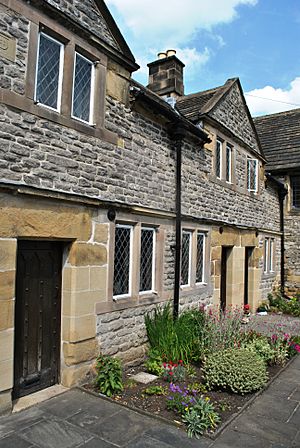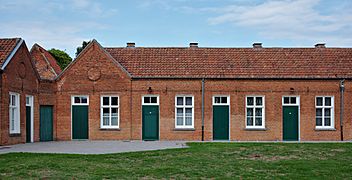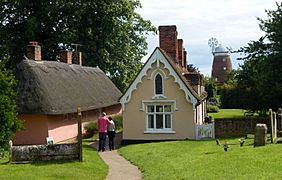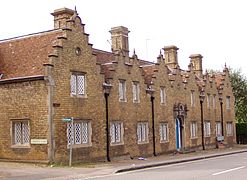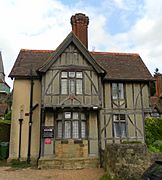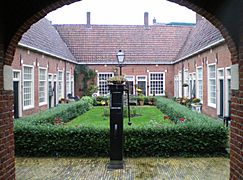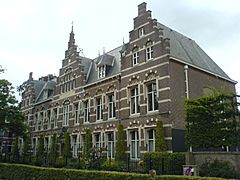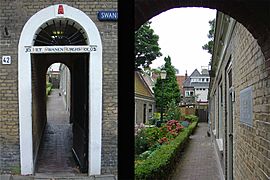Almshouse facts for kids

An almshouse (also called a bede-house) was a type of charitable housing. It provided homes for people in a community, especially during the Middle Ages. These homes often helped people who were poor, or those who used to work in certain jobs, or their widows. They also helped elderly people who could no longer pay rent. Charities or special funds usually maintained almshouses. The word "alms" means money or help given to support people in need. Almshouses first started as part of the church system. Later, local officials also helped run them.
Contents
History of Almshouses
Many almshouses began in Europe as Christian institutions. However, some were not religious. Almshouses offered affordable homes. They often included social support too, like people who looked after the residents.
Almshouses in England

Almshouses started in Britain around the 10th century. They gave homes to poor, old, and struggling people. They were sometimes called bede-houses. The people living there were called bedesmen or bedeswomen. The word bede is an old Anglo-Saxon word for prayer. The residents were expected to pray for the person who started the charity.
The first recorded almshouse was in York. King Athelstan founded it. The oldest one still standing is the Hospital of St. Cross in Winchester, built around 1132. In the Middle Ages, many European hospitals were actually almshouses. Many medieval almshouses in England were built to help the founder's soul. They usually had a chapel inside. Because of this, many were seen as chantries. They were closed down during the Reformation in the 1540s.
A law called the Act for the Relief of the Poor helped create civil almshouses and workhouses in England. These places changed over time. By 1900, about 85% of the people living in these institutions were elderly.
Today, almshouses are usually charities. They help residents live independently. A key difference is that people in almshouses don't have the same legal rights as regular renters. They depend on the kindness of the people running the charity. About 2,600 almshouses still operate in the UK. They provide 30,000 homes for 36,000 people.
Almshouses in the Netherlands
Almshouses first appeared in Holland during the Middle Ages. Rich citizens or guilds (groups of workers) often founded them. These almshouses created a well-organized system to help people. Many hofjes (Dutch almshouses) still provide homes for elderly people today. Most residents are women.
Almshouses in Norway
The first known almshouse in Norway was set up in Stavanger in 1269 or 1270.
Almshouses in the United States
The idea of almshouses from England came to the Commonwealth of Pennsylvania. William Penn brought this tradition. The Maryland government also created almshouses. They were paid for by property taxes. Massachusetts also had many almshouses. In the United States, help was often limited to the elderly and disabled. Children sometimes had to sleep in the same rooms as adults.
The first almshouse in the United States was in Boston, Massachusetts, in 1622. The original Boston Almshouse burned down in 1682. It was rebuilt away from the city center about ten years later.
In 1884, a study of Massachusetts almshouses showed there were four in Boston. There were 225 across the state. These almshouses housed almost 7,000 people. About 700 of these residents were thought to have a mental illness. Half of these almshouses did not house children.
In some early almshouses, conditions could be very harsh. For example, at the Pennsylvania Hospital, some people with mental health issues were treated poorly. Before the American Civil War, local officials managed almshouses. They did not always make sure people were cared for properly. By the 1860s, states like New York started creating boards. These boards regulated, inspected, and reported on almshouses. This helped improve conditions.
Throughout the 19th century, almshouses were a last resort for the poor, disabled, and elderly. Residents sometimes faced difficult conditions. Activists like Dorothea Dix fought for changes. Dix wanted to move children, people with mental illness, and people with developmental disabilities out of almshouses. She wanted more special institutions and hospitals for them. Her work helped create and expand over 30 hospitals for mental health treatment. Her efforts helped specific groups leave almshouses, leaving mostly the elderly.
A big problem was that almshouses were expensive to run. It was hard for residents to pay for their own care by working. There were often not enough staff or good facilities. By the end of the 1800s, other types of institutions, like asylums, began to replace almshouses.
What Almshouses Looked Like
Almshouses were often small terraced houses or apartments. They provided homes for a few residents. The buildings might be shaped like a "U" around a shared courtyard. Some places also had a chapel for religious services.
The Bakewell Almshouses in Derbyshire, England, were built in 1709. They were originally six separate homes. That's why you can still see six front doors today. Each home had one tiny room downstairs and one upstairs. There was no bathroom, toilet, or kitchen. The Manners family, who were Dukes of Rutland, looked after the building until 1920. They gave it to the charity that ran it. By 2001, the homes were in bad shape due to money problems. They were fixed up between 2004 and 2006 for £325,000. This money came from donations and grants. Now, they are three larger homes with modern facilities, but they still keep many historical features.
Almshouses in Books
The most famous almshouse in literature is probably Hiram's Hospital. It is the main setting in Anthony Trollope's novel The Warden. It also appears in the book's sequel, Barchester Towers.
Gallery
-
Almshouses at the parish church of St John in Thaxted, England
-
The almshouse at Woburn, Bedfordshire, England
-
Queens' College, Cambridge, England, almshouses in 1912
-
Boshuisengasthuis in Leeuwarden, Netherlands
-
Nieuw Sint-Anthony Gasthuis in Leeuwarden, Netherlands
-
Swanenburghshof in Gouda, South Holland
See also
- Blockley Almshouse
- Carroll County Almshouse and Farm, Westminster, Maryland
- Halfway house
- Hostel
- List of almshouses in Ireland
- List of almshouses in the United Kingdom
- Poorhouse
- Workhouse


